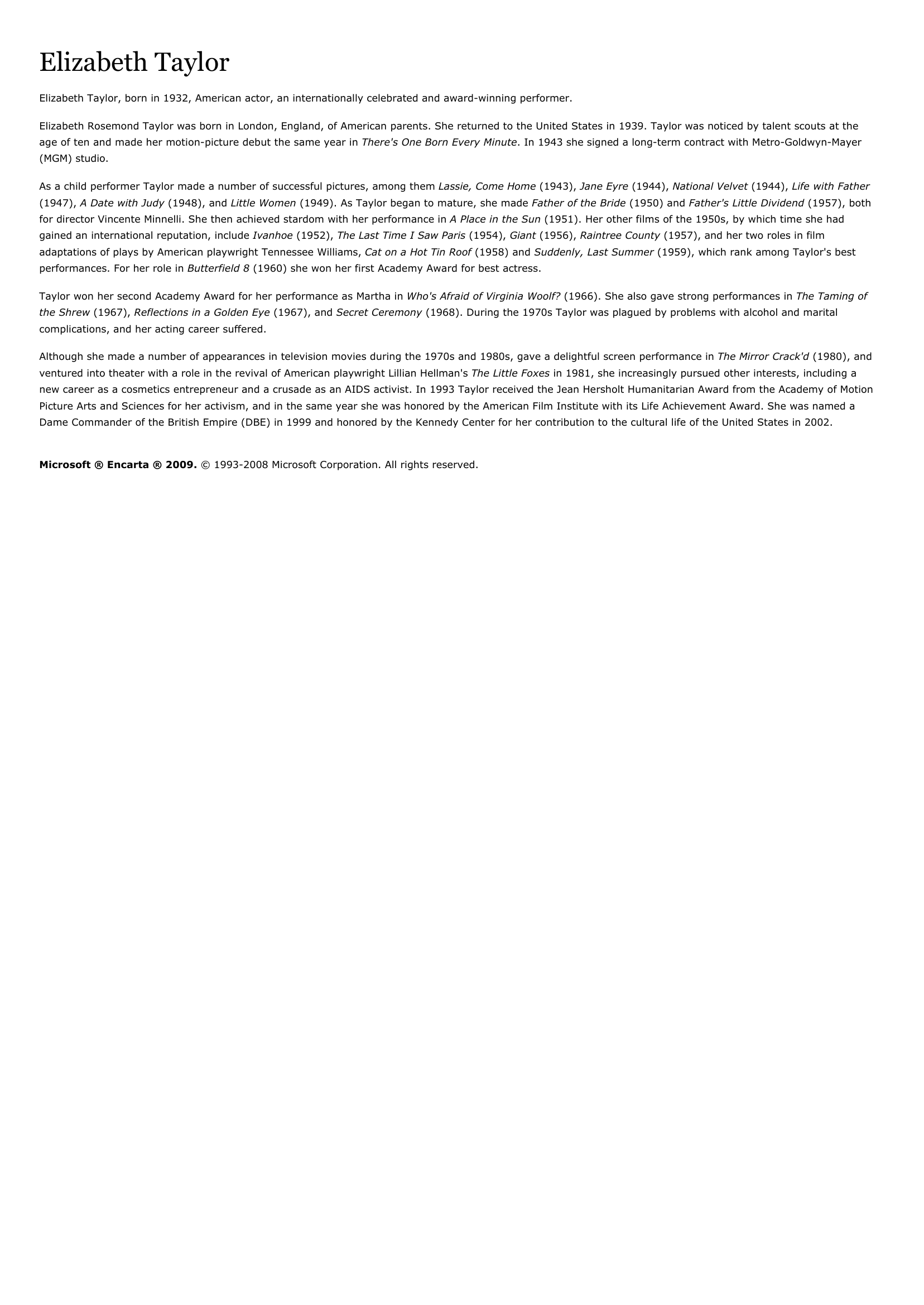Taylor (Elizabeth, dite Liz)
Publié le 31/03/2019
Extrait du document
Taylor (Elizabeth, dite Liz) Actrice américaine d'origine britannique
* 27.2.1932, Londres
Connue à Hollywood dès 1950 grâce à \"Une Place au soleil\", Liz Taylor enchaîne ensuite film sur film : \"Géant\" (1956), \"La Chatte sur un toit brûlant\" (1958), \"Boom\" (1963), \"La Mégère apprivoisée\" (1967). Elle doit toutefois son image de star hollywoodienne à \"Cléopâtre\" (1963), peplum fleuve dans lequel elle joue le rôle-titre. Elle reçoit pour cette performance le cachet sans précédent pour une actrice, de un million de dollars. Sa vie privée, jalonnée de crises conjugales (à deux reprises, elle épouse Richard Burton), contribue également à sa célébrité. Elle reçoit deux Oscars, l'un en 1960 pour \"La Vénus au vison\", l'autre en 1966 pour \"Qui a peur de Virginia Woolf ? \". Liz Taylor, qui n'apparaît plus que rarement au cinéma (\"Le Miroir se brisa\", 1980 ; \"Toscanini\", 1988), a publié ses mémoires en 1988 sous le titre : \"Être grosse, être mince, être heureuse\". Depuis la mort de Rock Hudson, son partenaire dans \"Géant\", l'actrice apporte son soutien à la recherche sur le Sida, une action qui lui vaut, en 1993, un Oscar spécial.
«
Powered by TCPDF (www.tcpdf.org)Elizabeth Taylor
Elizabeth Taylor , born in 1932, American actor, an internationally celebrated and award-winning performer.
Elizabeth Rosemond Taylor was born in London, England, of American parents.
She returned to the United States in 1939.
Taylor was noticed by talent scouts at theage of ten and made her motion-picture debut the same year in There's One Born Every Minute .
In 1943 she signed a long-term contract with Metro-Goldwyn-Mayer (MGM) studio.
As a child performer Taylor made a number of successful pictures, among them Lassie, Come Home (1943), Jane Eyre (1944), National Velvet (1944), Life with Father (1947), A Date with Judy (1948), and Little Women (1949).
As Taylor began to mature, she made Father of the Bride (1950) and Father's Little Dividend (1957), both for director Vincente Minnelli.
She then achieved stardom with her performance in A Place in the Sun (1951).
Her other films of the 1950s, by which time she had gained an international reputation, include Ivanhoe (1952), The Last Time I Saw Paris (1954), Giant (1956), Raintree County (1957), and her two roles in film adaptations of plays by American playwright Tennessee Williams, Cat on a Hot Tin Roof (1958) and Suddenly, Last Summer (1959), which rank among Taylor's best performances.
For her role in Butterfield 8 (1960) she won her first Academy Award for best actress.
Taylor won her second Academy Award for her performance as Martha in Who's Afraid of Virginia Woolf? (1966).
She also gave strong performances in The Taming of the Shrew (1967), Reflections in a Golden Eye (1967), and Secret Ceremony (1968).
During the 1970s Taylor was plagued by problems with alcohol and marital complications, and her acting career suffered.
Although she made a number of appearances in television movies during the 1970s and 1980s, gave a delightful screen performance in The Mirror Crack'd (1980), and ventured into theater with a role in the revival of American playwright Lillian Hellman's The Little Foxes in 1981, she increasingly pursued other interests, including a new career as a cosmetics entrepreneur and a crusade as an AIDS activist.
In 1993 Taylor received the Jean Hersholt Humanitarian Award from the Academy of MotionPicture Arts and Sciences for her activism, and in the same year she was honored by the American Film Institute with its Life Achievement Award.
She was named aDame Commander of the British Empire (DBE) in 1999 and honored by the Kennedy Center for her contribution to the cultural life of the United States in 2002.
Microsoft ® Encarta ® 2009. © 1993-2008 Microsoft Corporation.
All rights reserved..
»
↓↓↓ APERÇU DU DOCUMENT ↓↓↓
Liens utiles
- Taylor (Elizabeth, dite Liz)
- Dame Elizabeth Taylor - KUNSTLER.
- Taylor, Elizabeth - acteur / actrice.
- Elizabeth Taylor Elizabeth Taylor, born in 1932, American actor, an internationally celebrated and award-winning performer.
- Elizabeth Taylor.

































